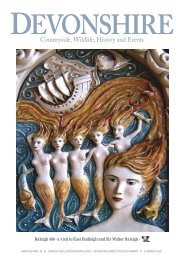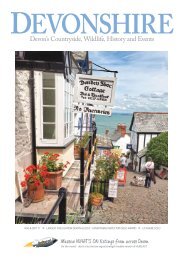Devonshire January February 18
You also want an ePaper? Increase the reach of your titles
YUMPU automatically turns print PDFs into web optimized ePapers that Google loves.
*Which brings us almost full<br />
circle and the mention again<br />
of the remains of the Lord<br />
Protector of England, Scotland<br />
and Ireland’s body being exhumed<br />
- on 30 <strong>January</strong> 1661, the 12th<br />
anniversary of the execution of<br />
Charles I - to be subjected to a<br />
posthumous execution.<br />
At least that is what the Royalists<br />
thought they had done.<br />
It had been buried in Westminster<br />
Abbey, amid great pomp and<br />
ceremony, alongside the body of<br />
his daughter, Elizabeth, who had<br />
died earlier.(Her tomb remained<br />
undisturbed)<br />
Photo: Rusty Aldwinckle, The Sealed Knot<br />
But was it really Cromwell’s body?<br />
It is thought by some that his<br />
family, friends and followers<br />
who could see what was coming<br />
had already removed the body<br />
and reburied it several times to<br />
cheat the vengeful Royalists of<br />
their grisly goal. Cambridgeshire,<br />
London, Northamptonshire and<br />
Yorkshire are all places that have<br />
been suggested - whilst that head<br />
itself, when it was finally lifted<br />
from its spike outside Westminster<br />
Hall, finished up beneath the floor<br />
of the antechapel at Sidney Sussex<br />
College, Cambridge. But whose<br />
head, warts and all?<br />
Footnote<br />
The Royalists scattered towards<br />
Cornwall: it was the beginning<br />
of the end of resistance by<br />
their forces in the west and led<br />
eventually to the capture and<br />
execution of the King. Dartmouth<br />
and Exeter surrendered to the<br />
New Model Army in April 1646.<br />
TYBURN, 1661: Cromwell's remains were thrown into a pit<br />
after a posthumous execution<br />
‘Black Tom’ and<br />
the Princess<br />
One of Fairfax’s first actions in<br />
the city was to issue an order<br />
whereby the young Princess<br />
Henrietta Anne, now aged three,<br />
was given written safe conduct to<br />
travel to London together with the<br />
loyal Lady Dalkeith and her small<br />
household. Once out of sight of<br />
their escort at the Devon border<br />
however, the good lady headed for<br />
Dover and then to France where<br />
she reunited the little girl with<br />
her mother. Did Fairfax connive<br />
at this deviation from the route?<br />
Lord Thomas Fairfax or ‘Black<br />
Tom’ as he was known to both<br />
sides was an honourable man on<br />
and off the battlefield. He opposed<br />
the execution of the king and as<br />
a consequence was pardoned by<br />
Charles II at the Restoration whilst<br />
many, many others were not.<br />
The vacated Cromwell vault in<br />
Westminster Abbey was later used<br />
as a burial place for eleven of<br />
Charles II's twelve illegitimate<br />
descendants - his illegitimate<br />
son, the Duke of Monmouth is<br />
buried - minus his head - beneath<br />
the chapel floor in the Tower of<br />
London, having been beheaded<br />
publicly for treason on 15 July<br />
1685, and his head displayed on<br />
a spike, not outside Westminster<br />
this time but on London Bridge.<br />
JOHN FISHER<br />
MANY THANKS to<br />
Rusty Aldwinckle<br />
for the use of the<br />
excellent photos in this piece.<br />
Details of where to see future<br />
re-enactments by The Sealed<br />
Knot in the 20<strong>18</strong> season can<br />
be found at:<br />
www.thesealedknot.org.uk<br />
hubcast<br />
.co.u k<br />
Find out what’s on in Devon<br />
97

















